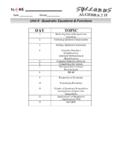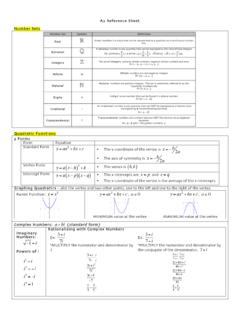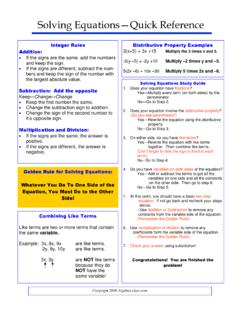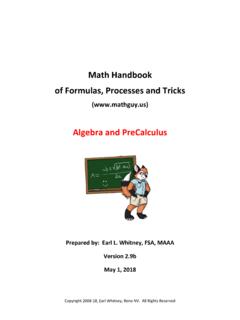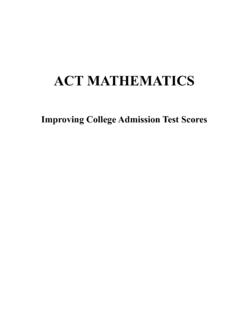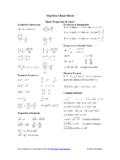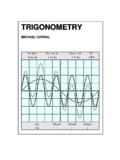Transcription of Georgia Standards of Excellence Curriculum Map …
1 Georgia Standards of Excellence Curriculum Map GSE Algebra I These materials are for nonprofit educational purposes only. Any other use may constitute copyright infringement. Mathematics Georgia Department of Education July 2017 Page 2 of 8 NOTE: Mathematical Standards are interwoven and should be addressed throughout the year in as many different units and tasks as possible in order to stress the natural connections that exist among mathematical topics. Grade 9-12 Key: Number and Quantity Strand: RN = The Real Number System, Q = Quantities, CN = Complex Number System, VM = Vector and Matrix Quantities Algebra Strand: SSE = Seeing Structure in Expressions, APR = Arithmetic with Polynomial and Rational Expressions, CED = Creating Equations, REI = Reasoning with Equations and Inequalities Functions Strand: IF = Interpreting Functions, LE = Linear and Exponential Models, BF = Building Functions, TF = Trigonometric Functions Geometry Strand: CO = Congruence, SRT = Similarity, Right Triangles, and Trigonometry, C = Circles, GPE = Expressing Geometric Properties with Equations, GMD = Geometric Measurement and Dimension, MG = Modeling with Geometry Statistics and Probability Strand.
2 ID = Interpreting Categorical and Quantitative Data, IC = Making Inferences and Justifying Conclusions, CP = Conditional Probability and the Rules of Probability, MD = Using Probability to Make Decisions GSE Algebra I Curriculum Map 1st Semester 2nd Semester Unit 1 (4 5 weeks) Unit 2 (4 5 weeks) Unit 3 (6 7 weeks) Unit 4 (5 6 weeks) Unit 5 (4 5 weeks) Unit 6 (4 5 weeks) Relationships Between Quantities and Expressions Reasoning with Linear Equations and Inequalities Modeling and Analyzing Quadratic Functions Modeling and Analyzing Exponential Functions Comparing and Contrasting Functions Describing Data These units were written to build upon concepts from prior units, so later units contain tasks that depend upon the concepts addressed in earlier units.
3 All units will include the Mathematical Practices and indicate skills to maintain. Georgia Department of Education July 2017 Page 3 of 8 Georgia Standards of Excellence Algebra I Curriculum Map Rationale Unit 1: Students will interpret the structure of expressions and solve problems related to unit analysis. Students will address properties of rational and irrational numbers and operations with polynomials in preparation for working with quadratic functions later in the course. Content addressed in Unit 1 will provide a solid foundation for all subsequent units. Unit 2: Building on Standards from middle school, students will analyze linear functions only. Students will (1) investigate key features of graphs; (2) create, solve, and model graphically linear equations and inequalities in one and two variables; (3) create, solve, and model graphically systems of linear equations in two variables; (4) create and interpret systems of inequalities where applicable; for example, students will create a system to define the domain of a particular situation, such as a situation limited to the first quadrant; the focus is not on solving systems of inequalities; (5) rearrange formulas to highlight a quantity of interest; (6) recognize arithmetic sequences as linear functions.
4 Some of the Unit 2 Standards will be repeated in Units 3, 4, and 5 as they also apply to quadratic and exponential functions. Unit 3: Students will analyze quadratic functions only. Students will (1) investigate key features of graphs; (2) solve quadratic equations by taking square roots, factoring (x2 + bx + c AND ax2 + bx + c), completing the square, and using the quadratic formula; (3) compare and contrast graphs in standard, vertex, and intercept forms. Students will only work with real number solutions. Unit 4: Students will analyze exponential functions only. Students will (1) investigate key features of graphs; (2) create, solve, and model graphically exponential equations; (3) recognize geometric sequences as exponential functions. Unit 5: Students will compare and contrast linear, quadratic, and exponential functions in this unit. Unit 6: Students will summarize, represent, and interpret data on a single count or measurement variable.
5 Students will summarize, represent, and interpret data on two categorical and quantitative variables. Students will interpret linear models. The pacing suggested above will allow students to gain a foundation in linear, quadratic, and exponential functions before they are brought together to be compared/contrasted in Unit 5. Although units 2, 3, and 4 look lengthy in terms of the number of Standards , only their application to one function type per unit will be addressed. As key characteristics of functions are introduced in unit 2 and revisited within units 3, 4, and 5, students will gain a deeper understanding of such concepts as domain and range, intercepts, increasing/decreasing, relative maximum/minimum, symmetry, end behavior, and the effect of function parameters. Unit 5 will provide an excellent opportunity for review of many concepts in preparation for the administration of the Georgia Milestones EOC assessment.
6 Georgia Department of Education July 2017 Page 4 of 8 GSE Algebra I Expanded Curriculum Map 1st Semester Standards for Mathematical Practice 1 Make sense of problems and persevere in solving them. 2 Reason abstractly and quantitatively. 3 Construct viable arguments and critique the reasoning of others. 4 Model with mathematics. 5 Use appropriate tools strategically. 6 Attend to precision. 7 Look for and make use of structure. 8 Look for and express regularity in repeated reasoning. 1st Semester Unit 1 Unit 2 Unit 3 Relationships Between Quantities and Expressions Reasoning with Linear Equations and Inequalities Modeling and Analyzing Quadratic Functions Extend the properties of exponents to rational exponents. Rewrite expressions involving radicals and rational exponents using the properties of exponents. ( , simplify and/or use the operations of addition, subtraction, and multiplication, with radicals within expressions limited to square roots).
7 Use properties of rational and irrational numbers. Explain why the sum or product of rational numbers is rational; why the sum of a rational number and an irrational number is irrational; and why the product of a nonzero rational number and an irrational number is irrational. Reason quantitatively and use units to solve problems. Use units of measure (linear, area, capacity, rates, and time) as a way to understand problems: a. Identify, use, and record appropriate units of measure within context, within data displays, and on graphs; b. Convert units and rates using dimensional analysis (English-to-English and Metric-to-Metric without conversion factor provided and between English and Metric with conversion factor); c. Use units within multi-step problems and formulas; interpret units of input and resulting units of output. Define appropriate quantities for the purpose of descriptive modeling. Given a situation, context, or problem, students will determine, identify, and use appropriate quantities for representing the situation.
8 Choose a level of accuracy appropriate to limitations on measurement when reporting quantities. For example, money situations are generally reported to the nearest cent (hundredth). Also, an answers precision is limited to the precision of the data given. Interpret the structure of expressions. Interpret expressions that represent a quantity in terms of its context. Interpret parts of an expression, such as terms, factors, and coefficients, in context. Given situations which utilize formulas or expressions with multiple terms and/or factors, interpret the Create equations that describe numbers or relationships. Create equations and inequalities in one variable and use them to solve problems. Include equations arising from linear, quadratic, simple rational, and exponential functions (integer inputs only). Create linear, quadratic, and exponential equations in two or more variables to represent relationships between quantities; graph equations on coordinate axes with labels and scales.
9 (The phrase in two or more variables refers to formulas like the compound interest formula, in which A = P(1 + r/n)nt has multiple variables.) Represent constraints by equations or inequalities, and by systems of equations and/or inequalities, and interpret data points as possible ( a solution) or not possible ( a non-solution) under the established constraints. Rearrange formulas to highlight a quantity of interest using the same reasoning as in solving equations. Examples: Rearrange Ohm s law V = IR to highlight resistance R; Rearrange area of a circle formula A = r2 to highlight the radius r. Understand solving equations as a process of reasoning and explain the reasoning. Using algebraic properties and the properties of real numbers, justify the steps of a simple, one-solution equation. Students should justify their own steps, or if given two or more steps of an equation, explain the progression from one step to the next using properties.
10 Solve equations and inequalities in one variable. Solve linear equations and inequalities in one variable including equations with coefficients represented by letters. For example, given ax + 3 = 7, solve for x. Solve systems of equations. Show and explain why the elimination method works to solve a system of two-variable equations. Solve systems of linear equations exactly and approximately ( , with graphs), focusing on pairs of linear equations in two variables. Represent and solve equations and inequalities graphically. Interpret the structure of expressions. Use the structure of an expression to rewrite it in different equivalent forms. For example, see x4 y4 as (x2)2 - (y2)2, thus recognizing it as a difference of squares that can be factored as (x2 y2) (x2 + y2). Write expressions in equivalent forms to solve problems. Choose and produce an equivalent form of an expression to reveal and explain properties of the quantity represented by the expression.










